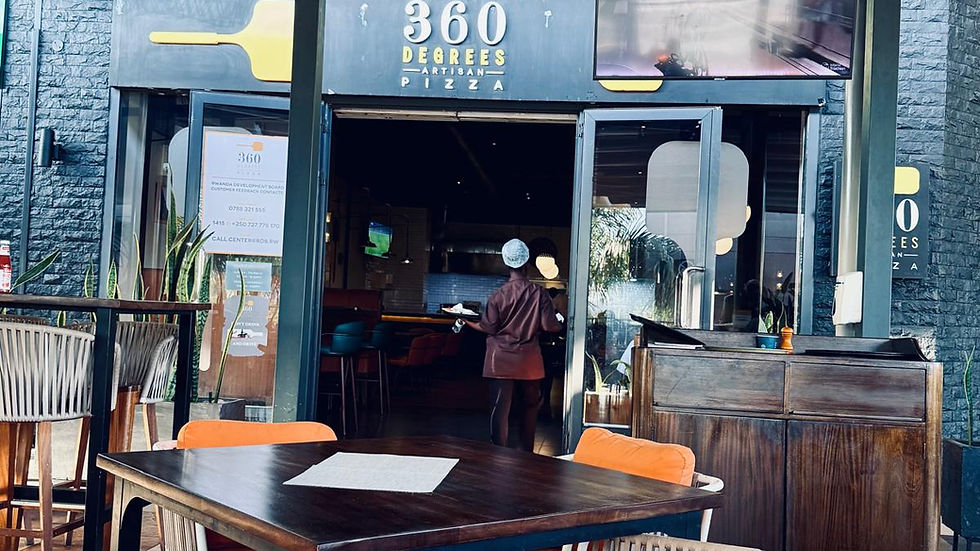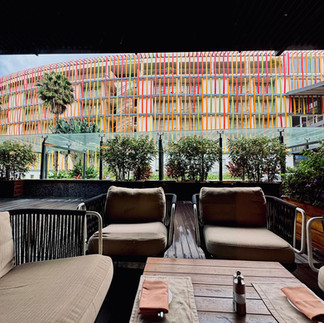Kigali: The Complete Guide to Rwanda's Remarkable Capital
- Samuel Ighalo
- Jun 13
- 9 min read
Updated: Jul 8

There's something remarkably striking about Kigali that hits you the moment you arrive. The city unfolds across emerald hills like a carefully planned tapestry. Impossibly clean streets weave between modern buildings and traditional neighborhoods. Beneath this surface of progress lies a story every visitor must reckon with—one of unimaginable tragedy and extraordinary resilience.
Having spent several days exploring this fascinating capital, I can confidently say that Kigali deserves far more than a brief stopover. This city rewards curiosity, challenges preconceptions, and leaves you with a profound appreciation for human resilience and possibility.
Discovering Kigali: A Journey of Resilience
The Heart of the City: Downtown Kigali

The city center pulsates with energy that's uniquely Rwandan—purposeful, organized, yet warmly human. The central business district showcases modern Rwanda’s ambitions. Gleaming office towers house everything from tech startups to international NGOs. However, it's the street level that captivates. You’ll find immaculately maintained sidewalks where vendors sell everything from fresh fruit to mobile phone credit. This bustling yet orderly environment creates a refreshing atmosphere.
The Union Trade Centre and Kigali City Tower represent the new Rwanda—modern commercial spaces that would fit into any global capital. Yet, step into nearby neighborhoods, and you’ll discover traditional compounds where families have lived for generations. This urban tapestry illustrates Rwanda's complex journey.
The Kigali Convention Centre: Africa's Crown Jewel

The Kigali Convention Centre isn't just a building; it's a statement. Rising majestically from the heart of the city, its distinctive dome and sleek lines illustrate Rwanda's bold leap into the future. I spent an afternoon exploring this architectural marvel, and I was truly impressed by its attention to detail.
The interior spaces flow seamlessly from one to another, with natural light flooding through carefully placed windows. The main auditorium, with its capacity for over 2,600 delegates, feels both intimate and grand. What struck me most was how the design incorporates traditional Rwandan elements. For instance, the dome itself draws inspiration from traditional royal palace architecture, while modern materials and technology bring it firmly into the 21st century.
The rooftop terrace offers breathtaking views across Kigali's hills. Standing there, watching the bustling city below, you grasp Rwanda's ambitions. It’s not just about hosting conferences; it's about positioning the country as a serious player on the continental and global stage.
The Kigali Genocide Memorial: A Journey Through Darkness and Light

No visit to Kigali is complete without confronting its most difficult chapter. The Kigali Genocide Memorial, located in Gisozi, serves both as a tomb and a testament. Here, over 250,000 victims of the 1994 genocide against the Tutsi are laid to rest, and their stories are preserved for future generations.
I'll be honest—this isn't an easy visit. The memorial guides you through events leading up to the genocide, the 100 days of killing, and the aftermath. The exhibitions are thoughtfully curated, using personal testimonies, photographs, and artifacts to convey a story that’s both deeply personal and historically significant.
What moved me most were the children's rooms, where clothes, toys, and photographs of young victims are displayed next to details of their short lives. It’s heartbreaking yet essential. The memorial doesn’t just document tragedy; it's a powerful reminder of our shared humanity and our responsibility to prevent such horrors.
The outdoor memorial gardens provide space for reflection. Rows of concrete slabs mark mass graves, while roses bloom between them—a beautiful metaphor for life persisting through devastation. Many visitors, both Rwandan and international, spend time here in quiet contemplation.
Kimisagara Youth Centre: Where Future Meets Past
While I didn’t have the chance to visit during my stay, the Kimisagara Youth Centre represents another crucial aspect of Kigali's narrative. Located in one of the city’s densest neighborhoods, this community center serves as a beacon of hope for young Rwandans. The center provides vocational training, sports programs, and cultural activities that help bridge the gap between Rwanda's difficult past and its promising future.
Local friends told me that visiting here offers a different perspective on post-genocide Rwanda. You get to see how communities are actively building resilience from the ground up, one young person at a time.
Nyamirambo: The Authentic Heart of Kigali
Nyamirambo is where you'll find the soul of old Kigali. This predominantly Muslim neighborhood pulses with energy quite different from the business district. The streets are narrower, the buildings more colorful, and the sense of community stronger. Though I only managed a brief walk through during my visit, even that short time revealed a neighborhood that locals call “the real Kigali.”
Famous for its vibrant nightlife, traditional restaurants, and the warmth of its residents, Nyamirambo is a must-visit. The Nyamirambo Women's Center, which I regretfully missed, offers walking tours led by local women, giving insights into daily life, traditional crafts, and the neighborhood's rich history.
This area is a culinary delight. You’ll find some of Kigali’s best local food here, from traditional Rwandan dishes to influences from diverse religious communities. The aromas wafting from small restaurants and street food vendors create a vibrant olfactory map of the neighborhood’s cultural diversity.
Inema Arts Center: Rwanda's Creative Renaissance
Inema Arts Center stands as a testament to Rwanda’s cultural rebirth. Founded by brothers Emmanuel and Innocent Nkurunziza, this vibrant space showcases contemporary Rwandan art gaining international recognition. While my schedule didn’t allow for a visit, the center’s reputation precedes it as a must-see destination for anyone interested in understanding modern Rwanda's creative spirit.
This center features works by local artists alongside international pieces. It fosters dialogue between Rwanda’s artistic traditions and global contemporary movements. More than a gallery, it's a working studio where visitors can watch artists at work and even participate in workshops.
Exploring Colonial History
Named after German explorer Richard Kandt, this museum occupies the former residence of Rwanda’s first European resident. Though I didn't manage to visit during my trip, the museum offers crucial context for understanding Rwanda’s colonial period and its impact on the country's development.
The exhibits trace Rwanda's history from pre-colonial times through independence. This historical context makes visiting other sites more meaningful. It’s particularly valuable for understanding the complex factors that contributed to the 1994 genocide.
King's Palace Museum (Rukari): Royal Heritage

Located about 20 minutes outside central Kigali, the King's Palace Museum preserves Rwanda's royal heritage. This traditional palace structure, with its distinctive dome shape that inspired the Convention Centre’s design, offers insight into pre-colonial Rwandan governance and culture.
The museum features traditional long-horned Inyambo cattle, which played essential ceremonial roles in Rwandan royal culture. While I didn’t have time for this excursion, visitors consistently rate it as one of their most enlightening experiences in the Kigali area.
Kigali's Thriving Food Scene

Kigali's culinary landscape reflects both its traditional roots and contemporary ambitions. From hole-in-the-wall spots serving authentic ugali and beans to upscale restaurants offering fusion cuisine, the city caters to every palate and budget.
Special mention goes to the coffee culture. Rwanda produces some of the world's finest arabica beans, and Kigali's cafés showcase this liquid gold beautifully. Spots like Questions Coffee and Bourbon Coffee not only serve excellent brews but also provide comfortable spaces for work or relaxation.
Traditional restaurants highlight local staples like ubugali (similar to polenta), ibirayi (potatoes), and fresh fish from Rwanda’s many lakes. The national beer, Mutzig, pairs perfectly with spicy tilapia or the popular brochettes (meat skewers).
Kigali's Hills: Natural Beauty Within the City
Kigali’s topography is its defining feature. Built across multiple hills, the city offers constantly changing perspectives and natural viewpoints. Mount Kigali, the highest point, provides panoramic views across the entire metropolitan area and beyond to the surrounding countryside.
Neighborhoods cascade down hillsides, creating an urban landscape unlike anywhere else in Africa. The integration of natural topography with urban planning results in a city that feels organic despite its careful organization.
The Spirit of Reconciliation and Progress
What strikes you most about Kigali today is how a society that experienced profound trauma has rebuilt itself. The city is immaculate—a source of pride for Rwandans. The last Saturday of each month is Umuganda, a community service day where everyone, from the president to ordinary citizens, participates in cleaning and community projects.
This communal spirit extends beyond cleaning. In markets, offices, and neighborhoods, Hutus and Tutsis work side by side, their children play together, and their shared Rwandan identity supersedes the ethnic divisions that once tore the country apart.
The transformation is remarkable, but it's not accidental. It’s the result of deliberate policies, community effort, and a collective decision to build something better from the ashes of tragedy.
Modern Innovations: The Digital Transformation
Kigali increasingly positions itself as East Africa's technology hub. The kLab innovation space, Carnegie Mellon University's campus, and numerous tech startups demonstrate Rwanda’s commitment to digital transformation. Though I didn’t explore this sector during my visit, signs of technological advancement are visible throughout the city.
The government's ambitious vision includes transforming Rwanda into a knowledge-based economy, with Kigali at the center of this transformation. Free WiFi in public spaces, widespread mobile money adoption, and a growing startup ecosystem all point to a digital future that's already arriving.
Shopping and Markets: From Traditional to Contemporary
Kimironko Market offers an authentic Kigali shopping experience I unfortunately missed but consistently hear praised by other travelers. This sprawling market sells everything from traditional crafts to electronics, providing insight into daily Rwandan life and commerce.
For a more contemporary shopping experience, Kigali City Market and various shopping centers offer air-conditioned comfort and international brands alongside local products. The contrast between traditional markets and modern shopping centers reflects Kigali's position between past and future.
Getting Around: Navigating the Hills

Kigali’s public transportation system centers around an efficient bus network connecting all major neighborhoods. The buses are clean, reliable, and remarkably affordable. For shorter distances, motorcycle taxis (called "motos") offer quick transport up and down the city’s hills, though they’re not for the faint-hearted.

Kigali’s infrastructure impresses consistently. Roads are well-maintained, traffic flows smoothly despite the hilly terrain, and pedestrian facilities make walking pleasant and safe. It’s a testament to thoughtful urban planning and constant maintenance.
Accommodation: Where to Stay
Kigali offers accommodation for every budget and preference. Luxury options like the Radisson Blu and Kigali Marriott provide international standards. Boutique hotels such as the Kigali Serena offer intimate experiences with local character.
Budget travelers will find excellent guesthouses and hostels, particularly in neighborhoods like Kimihurura and Remera. Many provide stunning views across the city's hills, proving that you don’t need to spend a fortune to wake up to beautiful vistas.
Day Trips and Nearby Attractions
Kigali serves as an excellent base for exploring central Rwanda. Lake Muhazi, about an hour away, provides opportunities for swimming, fishing, and peaceful retreats from urban energy. The drive showcases Rwanda's famous landscapes—the "thousand hills" that give the country its nickname.
Traditional villages near the capital allow for a glimpse into rural Rwandan life, traditional crafts, and agricultural practices. Many can be visited as day trips, though overnight stays offer deeper cultural immersion.
Practical Considerations for Visitors
Kigali is remarkably visitor-friendly. English is widely spoken alongside Kinyarwanda and French, making communication easier for international travelers. The city is considered one of Africa’s safest capitals, with low crime rates and a helpful police presence.
Banking and currency exchange are straightforward, with ATMs accepting international cards widely available. While many businesses accept credit cards, carrying some cash is advisable for markets and smaller establishments.
Climate and When to Visit

Kigali enjoys a pleasant climate year-round thanks to its altitude. The dry seasons (June-September and December-February) are ideal for exploring. Even during the rainy seasons, precipitation usually comes in predictable afternoon downpours, which don't significantly disrupt travel plans.
The city’s elevation keeps temperatures moderate—rarely too hot during the day and pleasantly cool at night. This climate has contributed to the city's development and continues to make it comfortable for both residents and visitors.
The Takeaway: A City of Lessons
As my plane lifted off from Kigali International Airport, I found myself looking down at those familiar rolling hills with deep respect. Kigali is a city, and a country, that has profound lessons to teach the world about resilience, forgiveness, and the power of choosing hope over hatred.
Kigali isn't just recovering from its past—it's building a future that honors memory while embracing possibilities. The juxtaposition of the forward-looking Convention Centre and the sobering Memorial captures this perfectly—a nation that remembers its past while relentlessly building towards tomorrow.

Beyond the headlines and tragic history, Kigali is a city of warm people, excellent coffee, genuine hope, and lessons in urban planning that other African capitals would do well to study. It’s a place where the past isn’t forgotten but doesn’t define the future.
Whether you have a day or a week, Kigali rewards the curious traveler with experiences that range from heartbreaking to inspiring, from culturally enriching to simply beautiful. It's a capital city that's still writing its story, and visitors become part of that narrative.
Essential Visitor Information
Getting There: Kigali International Airport is well-connected to major African and international destinations. The city is compact and easily navigable by taxi or motorcycle taxi.
Getting Around: Public buses are efficient and inexpensive. Motorcycle taxis provide quick transport but require nerves of steel. Walking is pleasant and safe in most areas.
When to Visit: Kigali enjoys a pleasant climate year-round, but the dry seasons (June-September and December-February) are ideal for exploring.
Planning Your Visit: Allow at least half a day for the Genocide Memorial—it deserves your full attention. The Convention Centre offers guided tours, and the views from the top are worth it alone.
Budget: Costs are reasonable by international standards. Budget $30-50/day for mid-range comfort, less for backpacker style, and more for luxury.
Language: Kinyarwanda, English, and French are all official. English is widely spoken in tourist areas and businesses.
Safety: Kigali is exceptionally safe by African capital standards. Use normal travel precautions but don't let safety concerns hinder your exploration.
Cultural Sensitivity: Rwandans are generally welcoming but appreciate respectful behavior, especially when discussing the genocide. Be mindful of local customs regarding photography, particularly at memorial sites.









Comments